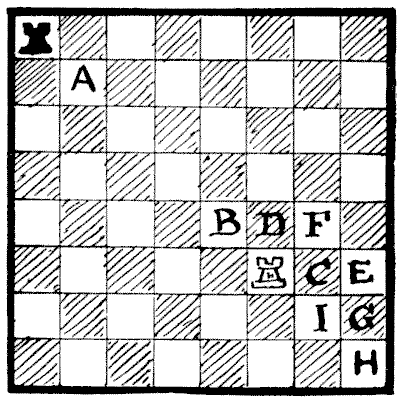(related to Problem: The Two Rooks)
The second player can always win, but to ensure his doing so he must always place his rook, at the start and on every subsequent move, on the same diagonal as his opponent's rook. He can then force his opponent into a corner and win. Supposing the diagram to represent the positions of the rooks at the start, then, if Black played first, White might have placed his rook at $A$ and won next move. Any square on that diagonal from $A$ to $H$ will win, but the best play is always to restrict the moves of the opposing rook as much as possible. If White played first, then Black should have placed his rook at $B$ ($F$ would not be so good, as it gives White more scope); then if White goes to $C,$ Black moves to $D;$ White to $E,$ Black to $F;$ White to $G,$ Black to $C;$ White to $H,$ Black to $I;$ and Black must win next move. If at any time Black had failed to move on to the same diagonal as White, then White could take Black's diagonal and win.

This eBook is for the use of anyone anywhere in the United States and most other parts of the world at no cost and with almost no restrictions whatsoever. You may copy it, give it away or re-use it under the terms of the Project Gutenberg License included with this edition or online at http://www.gutenberg.org. If you are not located in the United States, you'll have to check the laws of the country where you are located before using this ebook.